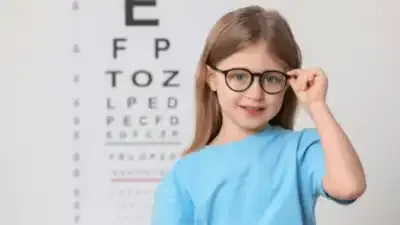
In recent years, more and more kids have been squinting at blackboards, struggling with blurry distance vision, and spending hours glued to screens. If you’ve noticed the same in your child—or even in yourself—you’re not alone. Myopia, also known as nearsightedness, is becoming increasingly common among children, especially after the pandemic shifted learning and leisure time indoors.
But what exactly causes myopia, and how can it be managed—or better yet, prevented? We spoke to Dr. Kavita Vadi, Consultant Ophthalmologist & Head, Clinical Services at Dr. Agarwals Eye Hospital in Mysore, to break down everything parents need to know. Here's a clear look (pun intended) at how myopia develops, why it’s on the rise, and what you can do to protect your child’s vision.
1. What exactly is myopia, and how does it affect the eye?
Myopia, commonly known as near or short sightedness, where person sees near vision clearly whereas distant objects appear blurry. In this condition the image from far object forms in front of the retina instead focusing on it.
This is because of elongated / long eye. It is one of the most common refractive errors, typically beginning in childhood and progressing through adolescence.
https://b775753a4f5c687e882fa9bebc430bc0.safeframe.googlesyndication.com/safeframe/1-0-45/html/container.html
2. What are the main causes or risk factors associated with developing myopia?
Risk factors for Myopia:
Genetics – family history, genetic risk being higher if both parents are myopic
Near work – prolonged near work activities like reading or using digital devices
Reduced outdoor activity – especially during childhood, exposure to nature & sunlight is a protective phenomenon
3. Have you seen an increase in myopia cases in recent years? If so, why do you think that is?
Yes, started during pandemic years where screen time usage is increased – both educational & recreational – coupled with reduced outdoor activities.
4. How does screen time or close-up work impact the development of myopia in children and adults?
In children, this will lead to elongation of the eyeball. Prolonged near work & screen time acts like a triggering factor. In adults, it will lead to visual fatigue, headaches & progression of existing myopia.
5. Are there any early signs or symptoms people should watch for to detect myopia early?
Blurred vision when looking at distant objects / blackboard
Squinting – when child tries to focus on distant objects
Frequent eye rubbing as a sign of eye strain or discomfort
Holding objects close to the face
6. What are the current treatment options for managing or slowing the progression of myopia?
Treatment options:
Corrective glasses or contact lenses
Orthokeratology (Ortho-K lenses) – using contact lens at night time to reshape the cornea
Low dose Atropine eye drops – clinically proven – helps to slow down the progression
Multifocal glasses – also helps to slow down the progression
Lifestyle changes – more of outdoor activities and regulated screen time
https://b775753a4f5c687e882fa9bebc430bc0.safeframe.googlesyndication.com/safeframe/1-0-45/html/container.html
7. Can myopia be reversed or cured, or is it a lifelong condition?
Myopia is a lifelong condition. Can’t be reversed but can be corrected (e.g., by LASIK procedure in adults) and treated in kids by glasses & preventing progression.
8. What role does genetics play in the likelihood of developing myopia?
Genetics plays a significant role, as risk is more with both parents than single parent.